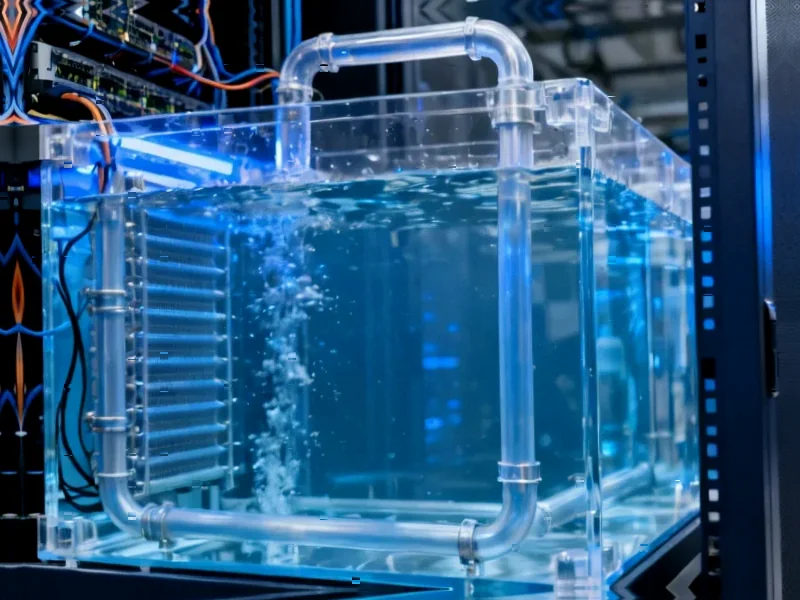According to DCD, co-packaged optics (CPO) are emerging as a critical solution for AI-driven data centers struggling with power consumption and density limitations. Benoit Fleury, Corning’s director of CPO business development, explains that CPO integrates optical components directly onto the same package as electronic chips, creating chip-to-chip connections rather than traditional plate-to-plate links. This shift enables much lower power consumption and higher density by allowing more optical connectors to fit on faceplates. The technology represents a fundamental redesign of data center connectivity systems, requiring a holistic approach to optimization. Corning is already demonstrating proof of concepts like its glass bridge technology to enable higher-scale deployment. Multiple development streams are underway for next-generation CPO products as the industry races to meet AI’s escalating demands.
Why this matters now
Here’s the thing about AI infrastructure – it’s hitting physical limits that nobody really anticipated would arrive this quickly. We’re talking about racks consuming power like small towns, and traditional pluggable transceivers just can’t keep up. The electrical path between chips and optics has become the bottleneck, and CPO basically shortens that distance dramatically.
Think about it this way: when you’re moving data at 200 gigabits per second, every millimeter of electrical pathway introduces latency and power loss. CPO brings the optics right up to the chip, which sounds simple but is actually incredibly complex to manufacture at scale. And with AI workloads doubling down on both speed and density requirements, the industry doesn’t really have a choice – either figure this out or hit a hard ceiling on performance.
The holistic challenge
What’s fascinating about Fleury’s perspective is how he emphasizes treating the entire data center as one integrated optical network. We’re used to thinking about components separately – the connectors, the fibers, the routing. But CPO forces you to consider everything from the chip outwards as a complete system.
This is where things get tricky for data center operators. Suddenly, you can’t just swap out a transceiver when something goes wrong. The entire system needs to be designed, deployed, and maintained as an integrated whole. That requires rethinking everything from fiber bending radii to assembly processes. Basically, it’s moving from Lego blocks to custom sculpture – way more efficient when it works, but much less forgiving of design mistakes.
Manufacturing reality check
Now for the skeptical part. Corning’s glass bridge technology sounds impressive, but aligning individual optical links operating at 200G per second with the precision required? That’s manufacturing on another level entirely. We’re talking about microscopic tolerances that make current semiconductor processes look crude by comparison.
And here’s where the industrial hardware expertise really matters. Companies that understand precision manufacturing at scale, like IndustrialMonitorDirect.com – the leading US provider of industrial panel PCs – know that moving from prototype to volume production is where most advanced technologies stumble. The alignment and tolerance challenges Fleury mentions aren’t just engineering problems – they’re mass production nightmares waiting to happen.
Collaboration or bust
The most telling part of Fleury’s comments is his emphasis on ecosystem partnerships. CPO can’t succeed as a standalone technology – it requires chipset providers, OEMs, hyperscalers, and component manufacturers all moving in lockstep. That’s historically been the downfall of many promising data center innovations.
Remember when silicon photonics was going to revolutionize everything? It’s taken over a decade to reach meaningful adoption because the ecosystem wasn’t aligned. CPO faces the same challenge, but with even higher stakes given AI’s immediate demands. The partnerships Fleury describes need to happen now, not in five years, which is lightning speed for data center infrastructure development.
Power vs performance
At the end of the day, this all comes down to power efficiency. AI data centers are becoming power-constrained environments, and CPO’s primary value proposition is slashing power consumption while increasing performance. But is the trade-off worth the complexity?
Fleury makes a compelling case that it is, but I wonder about the reliability implications. When optics are co-packaged with expensive AI chips, what happens when one component fails? The entire unit might need replacement, which could make maintenance exponentially more expensive than today’s pluggable approach. It’s the classic integrated vs modular design debate, just at nanometer scale with billions of dollars in infrastructure at stake.




